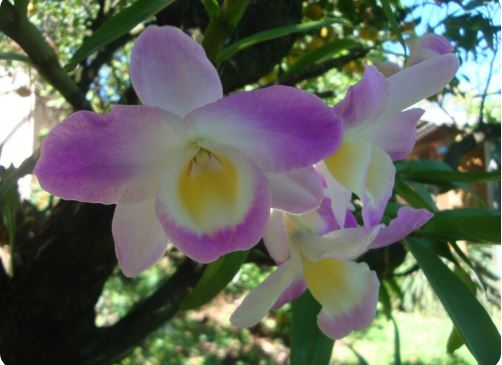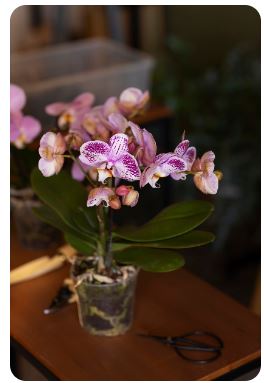Discover the Secrets to Thriving Indoor Orchids—the most elegant and exotic houseplants, adored for their stunning blooms and graceful appearance. While many struggle to keep them alive, these delicate beauties can flourish indoors for years with the proper care.
In this guide, we’ll reveal the Secrets to Thriving Indoor Orchids, from ideal lighting and watering techniques to expert tips on humidity and fertilization. Whether you’re a beginner or a seasoned grower, you’ll learn how to transform your orchids into healthy, long-lasting showstoppers.
Unlock the Secrets to Thriving Indoor Orchids and enjoy breathtaking flowers year after year—no greenhouse required!
In this comprehensive guide, you’ll learn:
✔ The best orchid varieties for indoor growing
✔ Proper lighting, watering, and humidity needs
✔ Essential potting and repotting tips
✔ Fertilizing and pest control strategies
✔ Troubleshooting common orchid problems
Whether you’re a beginner or an experienced grower, this guide will help you cultivate healthy, blooming orchids in your home.
1. Choosing the Right Orchid for Indoors

Not all orchids are the same—some are easier to grow indoors than others. Here are the best beginner-friendly orchids:
A. Phalaenopsis (Moth Orchid)

✅ Why it’s great for beginners:
- Thrives in typical indoor conditions
- Blooms last for months
- Low maintenance
🌡 Ideal temperature: 65–80°F (18–27°C)
💧 Watering: Once a week
B. Dendrobium Orchids
✅ Why choose Dendrobium?
- Tolerates slight neglect
- Produces multiple flower spikes
- Adapts well to indoor light
🌡 Ideal temperature: 60–85°F (15–29°C)
💧 Watering: Every 5–7 days
C. Oncidium (Dancing Lady Orchid)

✅ Why it’s unique:
- Fragrant blooms
- Prefers bright, indirect light
- Loves humidity
🌡 Ideal temperature: 55–80°F (13–27°C)
💧 Watering: Every 5–7 days
D. Cattleya Orchids
✅ Why they’re popular:
- Large, showy flowers
- Prefers bright light
- Moderate care level
🌡 Ideal temperature: 60–85°F (15–29°C)
💧 Watering: Every 5–7 days
Pro Tip: If you’re new to orchids, start with a Phalaenopsis—they’re the easiest to care for!
2. Orchid Light Requirements: Finding the Perfect Spot
Light is critical for orchid health. Too little light = no blooms. Too much light = burned leaves.
🔆 Best Light Conditions for Orchids
✔ Bright, indirect light (east or west-facing window)
✔ Filtered sunlight (sheer curtains help)
✔ Avoid direct midday sun (can scorch leaves)
🌿 Signs Your Orchid Needs More Light:
- Dark green, floppy leaves
- No flowering
- Weak growth
☀️ Signs Your Orchid Gets Too Much Light:
- Yellow or reddish leaves
- Dry, crispy leaf tips
- Sunburn spots
Artificial Light Option: If natural light is insufficient, use LED grow lights (12–14 hours/day).
3. Watering Orchids Correctly (The Biggest Mistake People Make!)
Overwatering is the #1 killer of orchids. Most orchids are epiphytes (they grow on trees, not in soil), so they need airflow around their roots.
💧 How to Water Orchids the Right Way
✔ Water only when the potting mix is nearly dry (stick your finger 1 inch deep—if dry, water).
✔ Use room-temperature water (avoid cold water).
✔ Soak, then drain (place the pot in water for 10–15 mins, then let excess water drain).
✔ Never let orchids sit in water (leads to root rot).
🚫 Common Watering Mistakes
❌ Watering on a strict schedule (check moisture first!)
❌ Using tap water with high minerals (use rainwater or distilled water if possible)
❌ Letting water sit in the crown (can cause rot—dry leaves with a paper towel)
Pro Tip: Orchids in bark mix dry out faster than those in moss. Adjust watering accordingly!
4. Humidity & Temperature: Creating the Ideal Environment
Most orchids love 40–70% humidity, which can be tricky in dry homes.
🌫 How to Increase Humidity for Orchids
✔ Use a humidity tray (pebbles + water under the pot)
✔ Group plants together (creates a microclimate)
✔ Use a room humidifier (best for consistent humidity)
✔ Mist lightly (but avoid wetting leaves too much)
🌡 Ideal Temperature Ranges
- Daytime: 65–80°F (18–27°C)
- Nighttime: Slightly cooler (55–65°F / 13–18°C)
Important: A 10–15°F drop at night helps trigger blooming in many orchids!
5. Orchid Potting & Repotting: When and How
Orchids need special potting mixes—regular soil suffocates their roots.
🌱 Best Potting Mixes for Orchids
✔ Bark-based mix (great for Phalaenopsis & Cattleya)
✔ Sphagnum moss (retains moisture, good for dry climates)
✔ LECA (clay pellets) (good for semi-hydroponic setups)
🔄 When to Repot Orchids
- Every 1–2 years (when the mix breaks down)
- Roots are overcrowded (growing out of the pot)
- After blooming (best time to repot)
✂️ How to Repot an Orchid (Step-by-Step)
- Soak the orchid (makes roots flexible).
- Remove old mix (gently untangle roots).
- Trim dead roots (black/mushy = bad, firm/green/white = good).
- Place in a new pot (only 1 size larger).
- Fill with fresh mix (press lightly to stabilize).
- Wait a few days before watering (lets roots heal).
Pro Tip: Use clear pots to monitor root health!
6. Fertilizing Orchids for Maximum Growth & Blooms
Orchids need nutrients but are sensitive to over-fertilizing.
🌿 Best Fertilizer Practices
✔ Use a balanced orchid fertilizer (20-20-20 or 10-10-10, diluted).
✔ Fertilize “weakly, weekly” (¼ strength every watering).
✔ Flush with plain water monthly (prevents salt buildup).
🌸 Encouraging Blooms
- Reduce fertilizer in winter (rest period).
- Provide cooler nights (triggers flowering).
- Ensure enough light (critical for blooms).
7. Common Orchid Pests & Diseases (And How to Fix Them)
Even with good care, orchids can face problems.
🐛 Common Orchid Pests
- Mealybugs (white, cottony spots) → Wipe with alcohol.
- Spider mites (tiny webs) → Spray with neem oil.
- Scale insects (brown bumps) → Scrape off & treat with insecticidal soap.
🦠 Common Orchid Diseases
- Root rot (black, mushy roots) → Repot & trim affected roots.
- Leaf spots (fungal/bacterial) → Remove infected leaves, improve airflow.
Prevention Tip: Good airflow + proper watering keeps most pests & diseases away!
8. Troubleshooting Common Orchid Problems
| Problem | Likely Cause | Solution |
|---|---|---|
| Yellow leaves | Overwatering, too much sun | Adjust watering, move to indirect light |
| Wrinkled leaves | Underwatering, low humidity | Soak orchid, increase humidity |
| No flowers | Not enough light, no temp drop | Move to brighter spot, provide cooler nights |
| Dropping buds | Sudden temp change, low humidity | Keep environment stable, mist lightly |
9. Final Tips for Long-Term Orchid Success
✔ Be patient—orchids grow slowly.
✔ Observe your plant—it will tell you what it needs.
✔ Don’t over-love them (less water = better than too much).
With the right care, your orchids can live for decades and bloom year after year!
Conclusion: Enjoy Your Thriving Orchids!
Growing orchids indoors is rewarding and achievable with the right knowledge. By providing proper light, water, humidity, and care, you’ll enjoy gorgeous, long-lasting blooms.






